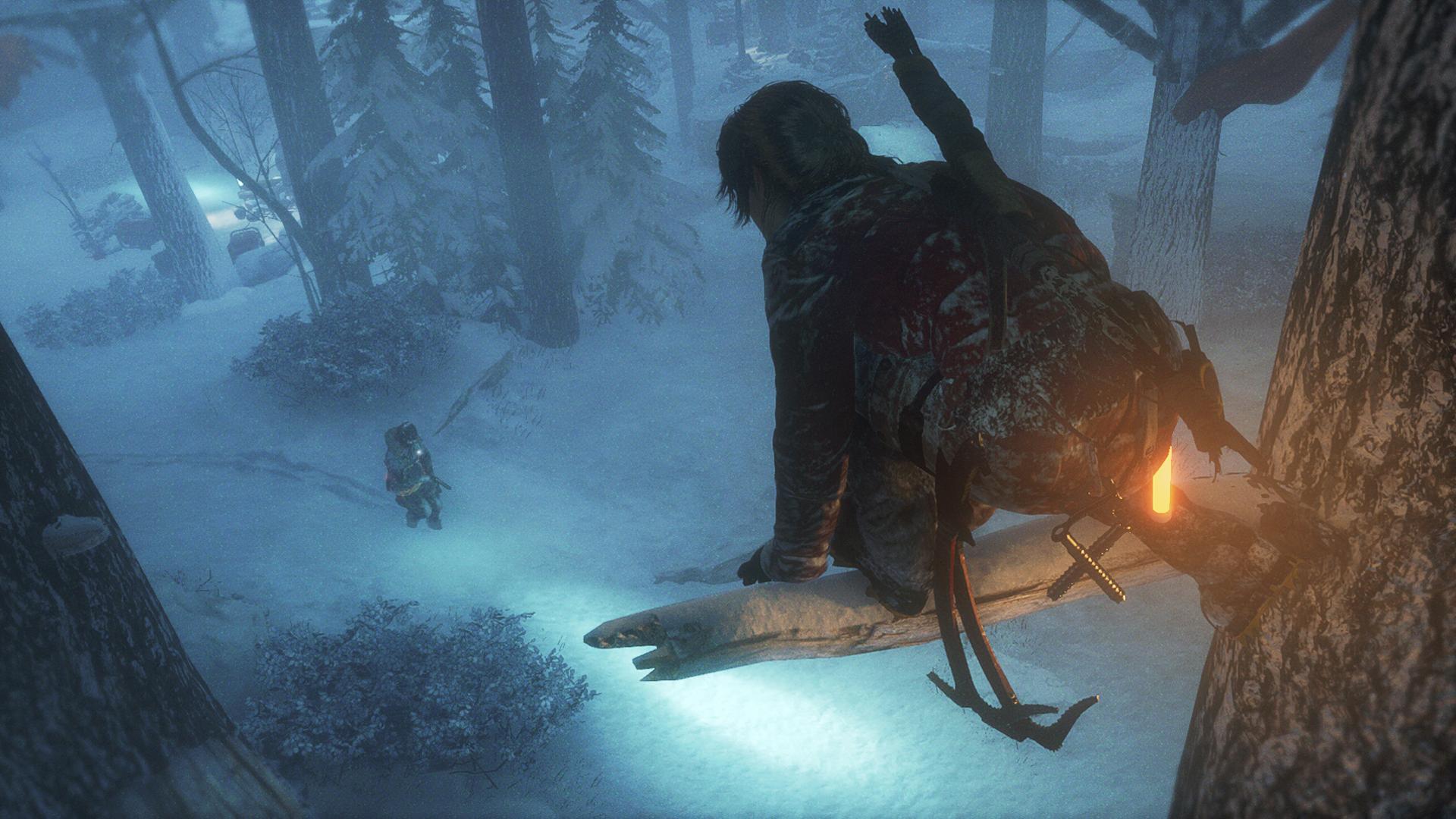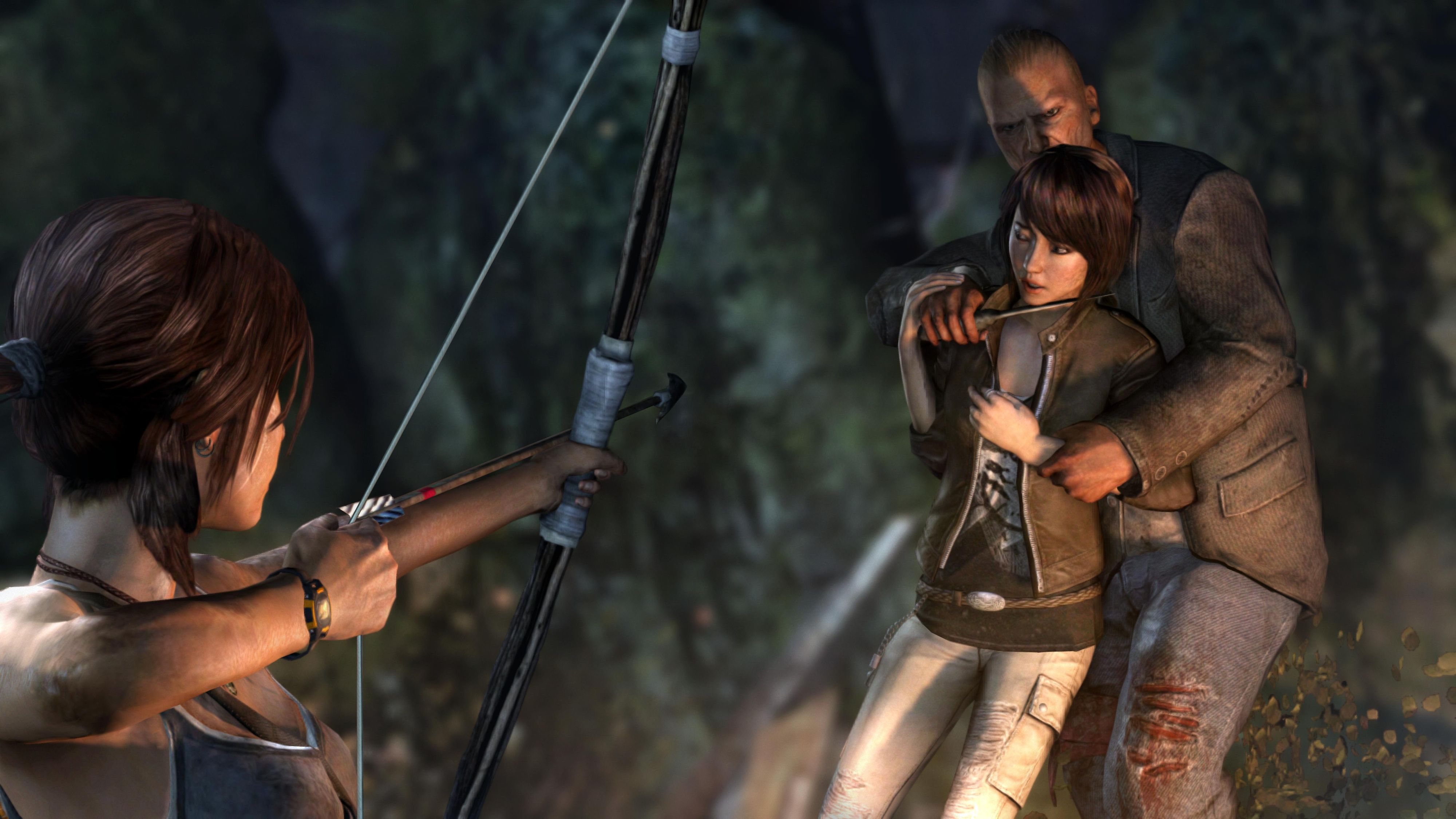Combat
From her physical appearance down to the supplies she takes on camping trips, Lara Croft underwent a dramatic metamorphosis for Crystal Dynamics's reboot. Her arsenal got retooled as well.
The image of Lara clutching a pistol in either hand was familiar to both fans and mainstream audiences. Hollywood starlet Angelina Jolie, who played the character in two films, sported dual pistols on promotional materials. Those pistols did more than put down threats. They stood for aptitude and poise. Wielding those handguns, players could jump, roll, and flip, all while lining up shots perfectly—like Indiana Jones, but more athletic.
Crystal Dynamics shelved those pistols for the 2013 reboot. "The introduction of the bow as a signature piece of gear was a major shift in combat: moving away from Lara's duel pistols," explained creative director Noah Hughes. "Part of that had to do with grounding her as a character fresh out of university. It's less believable that someone would be fully trained with full pistols, so we wanted to respect that as an origin story."

Lara takes aim in Tomb Raider 2013 (image courtesy of Crystal Dynamics).
Moreover, a bow communicated survival. Lara's new signature weapon symbolized her resourcefulness: that even when dropped on an island in the middle of nowhere, she could feed and defend herself with nothing more than a piece of wood and a string.
Players discovered pistols, shotguns, and other weapons as they played through the campaign, but venturing off-road gave them opportunities to scrounge out parts to upgrade gear. Reinforcing her bow allowed Lara to pull back further, increasing damage, while materials like additional magazines let her hold more bullets.
However, a strange dissonance existed between what weapons like the bow symbolized, and when and where they could be used. Players spend early portions of the game learning how to hunt animals to stay nourished and sneak up on enemies. Almost immediately after acquiring firearms, most encounters become bombastic: Enemies are alerted to Lara's presence no matter how stealthily players approach, and attack in mobs, rendering the bow untenable.
Crystal revamped combat in Rise of the Tomb Raider. All aspects of combat, from Lara's fluid mobility and her use of cover to weapons and her MacGyver-like crafting skills, were filtered through what the team referred to as the Lara lens.
"We tried to [offer] more resourceful approaches to combat," said Hughes. "When you come into combat, we tried to put you in a situation of enemies being unaware. That led to our stealth system and pre-combat situations. From there, more options on the battlefield. That included crafted items that leveraged Lara's resourcefulness, and things like swimming and trees, which leveraged her mobility."

Stealth is a more viable approach to encounters in Rise of the Tomb Raider (image courtesy of Crystal Dynamics).
Crystal wanted players to feel like Rambo—a warrior just as capable of slinking through wilderness and relying on the element of surprise as he is mowing down adversaries in a hail of bullets.
"Combat is fun when you can approach it in different ways. If you've got pockets full of ammo, go in guns blazing and have fun," said Hughes. "If you're strapped for ammo, you can take your time, observe the environment, and you'll often find a cleverer way to approach [combat]."
Violence begets violence. After playing Tomb Raider 2013, some players and critics seemed taken aback by how quickly Lara went from shedding tears over killing a deer, to murdering hundreds of human enemies.
"We were the first people to admit, when we were doing our internal postmortem, that there was dissonance between what you're doing and what we're asking you to do as Lara Croft, versus how we're making that develop as a narrative," recalled brand director Rich Briggs.
Noah Hughes admitted that showing Lara progress from hunting and killing animals to survive, to killing lots of bad guys was an aspect of her character that mediums such as books and film would have explored more thoroughly. Crystal had to accelerate that progression to get her to videogame-heroine status as soon as possible. The rub was making that narrative arc believable.
"It's a consistent piece of her character," Hughes said in regard to Lara falling back on violence to survive. "It's not something we just employed in that moment. We wanted to show that Lara isn't going to just give up; she's going to change when the world forces her to change, and we tried to create a believable moment where she crossed that line."
"It's a tricky balance you have to strike when making a video game," Briggs added. "People want action, and we wanted to deliver action as well. You can't necessarily show Lara being upset and grieving over every scavenger she defends herself against."

Lara tallied an impressive body count in Tomb Raider 2013, and had to work through her trauma in Rise of the Tomb Raider (image courtesy of Crystal Dynamics).
Rise of the Tomb Raider explored the psychological tool killing took on Lara. The game's debut trailer opened with Lara in a therapist's office, struggling to work through her ordeal on Yamatai. Acknowledging the difference between killing aliens or demons, versus killing human beings, was critical to reminding players that Lara was different from other videogame protagonists.
That difference extended beyond cinematics into gameplay scenarios. "In Rise, the first thing you see some Trinity soldiers do is shoot down an unarmed man," said Briggs. When they find Lara's encampment, they immediately shoot into her improvised shelter instead of saying something like, 'Come out with your hands up.' We try to show that these guys are trying to kill Lara and beat her to the secret of immortality, and they're going to do whatever they can to stop her, including kill her with no hesitation. Hopefully that gets you over the hump of, okay, these are bad guys."
Most ordinary people would crack under the pressure Lara faces on the simplest of tomb-raiding expeditions. By working violence and her reaction to having to commit violence into her character's evolution, Crystal is able to point to her as an example of endurance and perseverance. "It's what drove Amelia Earhart; it drove Jacques Cousteau," Briggs commented. "People who summit Mount Everest. This drive to push beyond where you think you would normally stop, all for the sake of adventure and pushing the human spirit further."
Puzzle Solving
Traditionally, puzzles in Tomb Raider games center on challenges within tombs. Like temples in Nintendo's Legend of Zelda series, tombs are sprawling areas made up of a series of interconnected rooms, and made up of varying flavors of brainteasers: traverse hazardous terrain to reach this area, find a way to this open doorway, locate a key or artifact, defeat such-and-such an enemy to advance to the next section.
Crystal Dynamics' 2013 reboot switched up that formula. Instead of fashioning a series of labyrinths with occasional jaunts into a larger setting, the designers positioned tombs as optional areas hidden throughout the island of Yamatai. Most consisted of a room or two and a puzzle for each, culminating in a chamber where players collected parts to upgrade their equipment.
As Noah Hughes explained, the team decided on that tack as an extension of player-controlled pacing. "I hear people say, 'The reboot doesn't have real tombs because they're optional. They have to be critical if it's a real Tomb Raider game.' We are committed to critical-path tombs, and we spend more time and resources on making those the best tombs in the game. However, this idea that you can find something that not everybody else will find, to me, compounds that sense of discovery."
Following completion of the reboot, Crystal assembled a postmortem to reflect on the development process. Part of that reflection entailed reading through reviews from critics and consumers, and evaluating what criticism should be addressed in 2015's Rise of the Tomb Raider.

Exploring a tomb in Rise of the Tomb Raider (image courtesy of Crystal Dynamics).
Unsurprisingly, the diminished role of tombs came up time and again, and not just from external sources. "In the Tomb Raider reboot," recalled Hughes, "I still wasn't entirely happy with the [quantity of tombs] in the end. Part of that had to do with scale and difficulty of puzzles in some cases, but another part was ancient and undiscovered places. We always have multiple layers of history, and we often have a modern layer, the layer that Lara exists in. There's also an ancient layer, the underpinning of the myth."
Most tombs in Tomb Raider 2013 were hidey-holes built during World War II. Hughes wanted the historical aspects of tombs to stretch back even further—centuries instead of decades. In answer, tombs in Rise grew larger, and while many were still optional, several were mandatory checkpoints on the path through the story.
"We talked about more tombs with ancient discovery, really delivering on that promise of more tomb raiding. Things like the translation system was us trying to deliver that more within the context of Lara's character," Hughes explained.
The idea of being able to read, speak, and write in several languages manifested as a skill called Language Proficiency. Players advanced their knowledge by hunting down documents and relics. As their Language Proficiency increases, Lara gained the ability to decipher writings and carvings on monoliths.
"All of that was us trying to layer in not just 'Survival 2.0,' but tomb raiding and Lara's brilliance, and pulling them back into gameplay systems more aggressively as well," said Hughes.

Returning to Croft Manor in the Blood Ties DLC for Rise of the Tomb Raider. Crystal Dynamics' interpretation of the iconic location featured all sorts of callbacks to Core's series, such as a stuffed T-Rex that Lara played with as a tyke (image courtesy of Crystal Dynamics).
Puzzles took different forms in expansion packs designed by the Live team. Will Kerslake and his cohorts relished any chance to tailor each expansion to specific Tomb Raider pillars. Cold Darkness Awakened, for instance, favored combat and puzzle solving. Entering an old Soviet weapons bunker, Lara faced aggressive enemies that attacked in packs and lobbed explosives, but the expansion's puzzles stole the show.
The idea is that Lara must shut down production of chemicals by taking certain steps. Those steps change slightly each time, forcing players to pay careful attention and serving as a pleasant interlude from overwhelming combat encounters.
"We wanted them to be replayable so that every time you do a mission, what you need to observe changes; and the actual items to observe change, as does what you need to do as a result of noticing all these changes," explained Kerslake. "It was fun to have that: every time I play through this space I get a slightly different experience."

